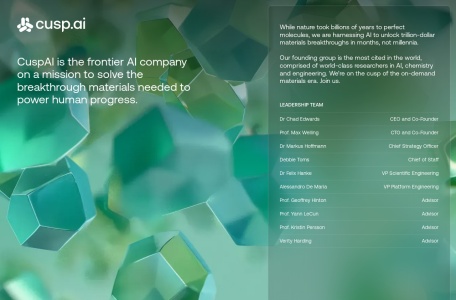What is CuspAI?
CuspAI is an AI-powered search tool for materials science developed by the University of Cambridge. Users only need to input the desired properties of a material, and CuspAI can quickly screen out potential molecular structures, accelerating the research process. In June 2024, CuspAI secured $30 million in seed funding, with Professor Max Welling serving as a co-founder and the Chief AI Officer. CuspAI is currently working on developing new materials for capturing and storing carbon dioxide, contributing to the global goal of carbon neutrality.
The main functions of CuspAI
- Material Property Search: Users can search for new materials based on specific properties.
- Molecular Structure Generation: AI generates possible material molecular structures according to user requirements.
- Rapid Screening and Evaluation: The system can quickly screen and evaluate a large number of novel structures.
- New Material Discovery: Users can describe the material properties they need, such as strength, conductivity, heat resistance, etc. CuspAI’s AI system will generate new material molecular structures that meet these properties.
- Carbon Capture and Storage: CuspAI focuses on designing materials capable of capturing and storing carbon dioxide, which is crucial for reducing greenhouse gas emissions and addressing climate change.
How to Use CuspAI
- Access Platform: Users need to visit the official website of CuspAI (cusp.ai).
- Registration and Login: Users are required to register an account and log in to use CuspAI’s services.
- Input Material Requirements: Users need to describe in detail the properties they want the new material to possess, such as mechanical strength, conductivity, thermal stability, optical properties, etc. They can also specify particular application scenarios, such as battery materials, catalysts, drug carriers, etc.
- AI Analysis and Generation: CuspAI’s AI system will analyze the user’s input requirements and use algorithms to generate molecular structures that meet these needs. The system will generate multiple candidate molecular structures for users to choose from.
- Screening and Optimization: Users can select the molecular structures they are interested in from the generated options and further optimize these structures to meet more specific performance requirements.
- Evaluation and Testing: CuspAI provides virtual evaluation tools to help users assess the performance of the selected molecular structures. Users can also send these molecular structures to a laboratory for actual testing and validation.
- Commercialization and Application: Once a suitable material molecular structure is identified, users can start considering how to commercialize these new materials and apply them to real-world products.
- Documentation and Reporting: Users can generate detailed reports and documents through the platform, recording the design process of the new materials and the results of performance evaluations.
The applicable population of CuspAI
- Material Scientists: Research scientists engaged in the research and development of new materials, who need to design materials with specific properties.
- Chemical Engineers: Professionals working in the field of chemical engineering, who need to develop new catalysts or improve existing processes.
- Environmental Scientists: Scientists focusing on environmental issues and solutions, including experts engaged in research on carbon capture and storage technologies.
- Energy Industry Experts: Professionals working in the fields of clean energy and sustainable energy technologies, who need to develop new energy storage materials.
- Educators and Students: In the field of academic education, teachers and students can use CuspAI as a learning and research tool.







